#language of nature
Text




There's a language between trees and sunlight, flowers and bees, wind and leaves, sea and sky, which I think we all should speak to each other.🍀
.
58 notes
·
View notes
Text



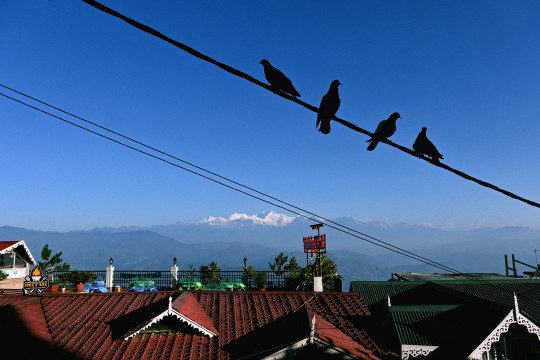
Kanchenjunga ❄✨
#kanchenjunga#darjeeling#travel#nature#traveldiaries#nikon#lightandshade#language of nature#landscape
5 notes
·
View notes
Text
"Floral Verse: Blooms in the Language of Love"

In "The Language of Flowers: The Floral Offering," Henrietta Dumont crafts a captivating exploration of the profound language spoken by nature's most delicate and vibrant creations. The book, akin to a poetic garden, not only delves into the symbolism of each blossom but also unveils the intricate poetry inherent in the language of flowers.
Dumont's work transcends a mere botanical dictionary, transforming the pages into an enchanting anthology where each bloom whispers secrets of affection and esteem. As readers meander through the verses, they find themselves immersed in a world where emotions are expressed through the delicate petals of nature's messengers.
The book unfolds like a fragrant tapestry, weaving together the meanings and emotions associated with various flowers. Dumont, with eloquent prose, explores the nuanced expressions of love, gratitude, and admiration that resonate in the floral realm. The Language of Flowers becomes a guide, teaching readers to decipher the silent conversations carried by blooms.
The author's meticulous research is evident as each page unfolds, revealing the historical and cultural significance of floral gestures. From the timeless rose symbolizing love to the humble daisy portraying innocence, Dumont unravels a rich tapestry of sentiments bound within the petals.
Beyond its botanical and linguistic explorations, the book serves as a source of inspiration. Dumont encourages readers to cultivate their personal floral language, fostering connections and understanding through the universal beauty of flowers. The Floral Offering becomes not just a book but a companion for those seeking to express sentiments in a language that transcends words.
In conclusion, Henrietta Dumont's "The Language of Flowers: The Floral Offering" is a poetic journey that unveils the profound and intricate language spoken by nature's floral emissaries. It is a celebration of the timeless beauty encapsulated in each blossom and an invitation to explore the language of love through the enchanting world of flowers.
"The Language of Flowers: The Floral Offering," Henrietta Dumont is available in Amazon in paperback 19.99$ and hardcover 24.99$ editions.
Number of pages: 415
Language: English
Rating: 7/10
Link of the book!
Review By: King's Cat
#Language of Flowers#Floral symbolism#Botanical poetry#Henrietta Dumont#Token of affection#Esteem and flowers#Botanical language#Floral communication#Symbolic blooms#Flower meanings#Nature's poetry#Bouquet sentiments#Blooms of love#Petal expressions#Floral messages#Romantic gestures#Language of nature#Symbolic tokens#Flower symbolism#Sentimental blooms#Henrietta Dumont book#Botanical meanings#Poetic blossoms#Affectionate flowers#Floral eloquence#Cultural symbolism#Flower traditions#Language of love#Floral sentiments#Esteem in blossoms
2 notes
·
View notes
Text
"Floral Verse: Blooms in the Language of Love"

In "The Language of Flowers: The Floral Offering," Henrietta Dumont crafts a captivating exploration of the profound language spoken by nature's most delicate and vibrant creations. The book, akin to a poetic garden, not only delves into the symbolism of each blossom but also unveils the intricate poetry inherent in the language of flowers.
Dumont's work transcends a mere botanical dictionary, transforming the pages into an enchanting anthology where each bloom whispers secrets of affection and esteem. As readers meander through the verses, they find themselves immersed in a world where emotions are expressed through the delicate petals of nature's messengers.
The book unfolds like a fragrant tapestry, weaving together the meanings and emotions associated with various flowers. Dumont, with eloquent prose, explores the nuanced expressions of love, gratitude, and admiration that resonate in the floral realm. The Language of Flowers becomes a guide, teaching readers to decipher the silent conversations carried by blooms.
The author's meticulous research is evident as each page unfolds, revealing the historical and cultural significance of floral gestures. From the timeless rose symbolizing love to the humble daisy portraying innocence, Dumont unravels a rich tapestry of sentiments bound within the petals.
Beyond its botanical and linguistic explorations, the book serves as a source of inspiration. Dumont encourages readers to cultivate their personal floral language, fostering connections and understanding through the universal beauty of flowers. The Floral Offering becomes not just a book but a companion for those seeking to express sentiments in a language that transcends words.
In conclusion, Henrietta Dumont's "The Language of Flowers: The Floral Offering" is a poetic journey that unveils the profound and intricate language spoken by nature's floral emissaries. It is a celebration of the timeless beauty encapsulated in each blossom and an invitation to explore the language of love through the enchanting world of flowers.
"The Language of Flowers: The Floral Offering," Henrietta Dumont is available in Amazon in paperback 19.99$ and hardcover 24.99$ editions.
Number of pages: 415
Language: English
Rating: 7/10
Link of the book!
Review By: King's Cat
#Language of Flowers#Floral symbolism#Botanical poetry#Henrietta Dumont#Token of affection#Esteem and flowers#Botanical language#Floral communication#Symbolic blooms#Flower meanings#Nature's poetry#Bouquet sentiments#Blooms of love#Petal expressions#Floral messages#Romantic gestures#Language of nature#Symbolic tokens#Flower symbolism#Sentimental blooms#Henrietta Dumont book#Botanical meanings#Poetic blossoms#Affectionate flowers#Floral eloquence#Cultural symbolism#Flower traditions#Language of love#Floral sentiments#Esteem in blossoms
0 notes
Text




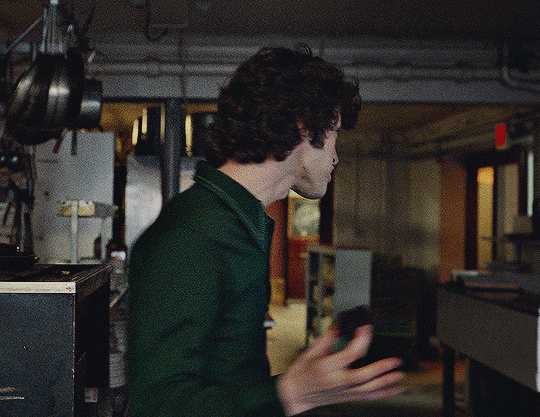





🤸 Dominic Sessa as Angus Tully 🤸 – The Holdovers (2023)
#the holdovers#dominic sessa#angus tully#films watched#filmgifs#dailyflicks#moviegifs#my gifs#need to make a specific post about how natural and fascinating the way he moves and uses his body language#imagine landing your first acting role and serving this much#SO ICONIC#the cartwheel alone deserves an oscar nom are you kidding me#and to know that it was just him improvising and payne said why tf not
1K notes
·
View notes
Photo

James Bligh & Henry Fox | A Place to Call Home
2016 ‧ 1950s ‧ Period Drama ‧ S04.E05
#nature#a place to call home#james x henry#david berry#tim draxl#kiss#queer#couple#gay#lgbt#lgbtq+#henry x james#lgbtedit#james bligh#henry fox#perioddramaedit#gay couple#aptch#affection#1950s#lake#intimacy#desire#lgbtqia#love language#period drama#queer media#romancegifs
9K notes
·
View notes
Text
Someone needs to do an analysis on the way the Kung Fu Panda movies use old-fashioned vs. modern language ("Panda we meet at last"/"Hey how's it going") and old-fashioned vs. modern settings (forbidden-city-esque palaces/modern-ish Chinese restaurant) to indicate class differences in their characters, and how those class differences create underlying tensions and misunderstandings.
#This is neither a criticism nor a compliment of that artistic choice#I just think it's really interesting#Like even looking at the Five:#Tigress talks in an older style than the others because she was mainly raised at the Jade Palace#While Mantis talks like Joe-schmo off the street because he *was* a streetfighter and an ordinary guy#Shifu and even Tai Lung talk like they're from an old-fashioned novel or kung fu movie#Po talks like a modern guy you'd meet working in a twenty-first century family restaurant#Part of Tigress's initial disdain for him in the first movie is clearly because she considers him to be low-class/a commoner#(And therefore an intruder into the world of the Jade Palace and the rest of the Kung Fu masters which appears to be semi-noble).#Shen looks genuinely off-put and disgusted when he has to respond to Po's greeting with a “...hey.”#And when Po wants to appear more legitimate as a warrior he adopts a more “legendary”/old-fashioned way of speaking.#In the aesthetic language of KFP old fashioned=noble/upper class and modern=common/lower class.#This translates entirely naturally—I think especially to an American audience—but it is wild once you notice it#Because you realize: “Hang on—shouldn't *all* these characters be talking like they're living in the medieval era?”#“And what does it mean that they're not? What is the movie attempting to convey with this—probably entirely subconscious—artistic choice?”#kung fu panda
918 notes
·
View notes
Text
thinking about how many turns of phrase are christianity-based, and was trying to think of how I'd explain "jesus wept" to someone who hadn't heard it used, and the closest thing I could come up with was "alexa, play despacito"
#sbs rambles#language#religion#I'm not wrong though#like ''jesus wept'' is the shortest verse in the bible and that's a whole thing#but when used as a phrase it's sarcastic in nature#so I think I'm right about this
572 notes
·
View notes
Text
you ever think about the fact that laios won not by being a monster but by being human.
monsters as we’ve seen throughout the manga are predictable, they have this rhythm to them that, once someone understands, can be used to take them out. take kelpies like anne where laios states that she is just a monster and cannot be trusted. even kensuke is “just a monster after all”, running away from danger when laios needs it most. kensuke is beloved by laios not just because he is a monster, but because laios, in human fashion, anthropomorphized him in his mind (giving him a name, etc.)
but people are different. they are multifaceted, non-monolithic creatures. long lived races are not all pious and apathetic towards short lived races as we see with marcille and senshi. chilchuck actively works against the prejudice against half-foots. tallmen from every region have their cultural differences as we see with shuro and laios/falin. even “demi-humans” like orcs have depth to them, having rich culture and values despite the general idea that they are a violent pillaging race.
even laios’ family and village, the nexus point for his dislike of people, have depth to them. though their parents did not actively protect their children, they did not wish harm on them either. the exorcisms performed on falin by their mother was harmful in laios’ eyes, but helpful in his mother’s perspective.
laios himself, despite loving monsters and hating humans, is so very painfully human. he hates humans but has risked life and literal limb to save his sister and his party. he loves monsters but is aware of their dangerous nature and spares them no mercy.
(big spoilers under the cut)
the winged lion mistook laios as a one dimensional entity, one which only operates on a one track mind without paradox. it thought laios to operate like a monster, and so it approached his desires like one. it believed that laios, being so obsessed with monsters, must behave like one as well, so completely disregarded the fact that laios could have something up his sleeve.
but laios is not a monster, he is human. he has ulterior motives, overlapping beliefs, contradicting values. it is his humanness that made him explain to his party what to do when things went awry. it is his humanness that allowed him to lie. lie to the world about his true plan as well as lie to the winged lion about his intentions.
sure laios WANTS to be a monster, that much is definitely true. but what he IS is a different story. laios is an unpredictable, sporadic, messy human being. it is that fact which the winged lion overlooked, and ultimately led to its downfall and laios’ victory.
#ohh the multifaceted nature of human beings and the beauty of the human condition#ryoko kui really outdid herself#dungeon meshi you will always be important to me#anyways don’t mind me i’m just having Laios thoughts#ignore the fact that i accidentally said two dimensional entity the first time i know language i swear#laios touden#laius thorden#???#dungeon meshi#delicious in dungeon#dunmeshi#dunmesh spoilers#the winged lion#rambles#ryoko kui#anime#manga#analysis
435 notes
·
View notes
Text
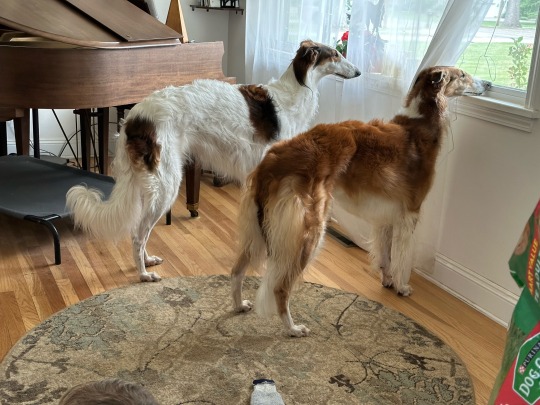
SUSPICIOUS
#dogblr#petblr#dog#borzoi#sighthound#margo#charlie#can I also point out#how Margo is holding her tail#is a very normal and regular borzoi tail set#anyone familiar with dog language but not borzoi anatomy/structure#may think it’s a tucked tail and she’s nervous or uncomfortable#but that is absolutely her normal and CORRECT borzoi tail#per the standard tails are to be long and low set#which makes for a tucked tail look when held naturally
2K notes
·
View notes
Text


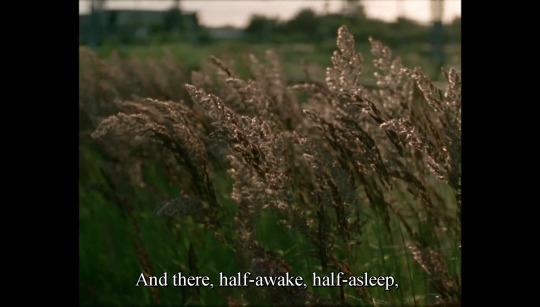
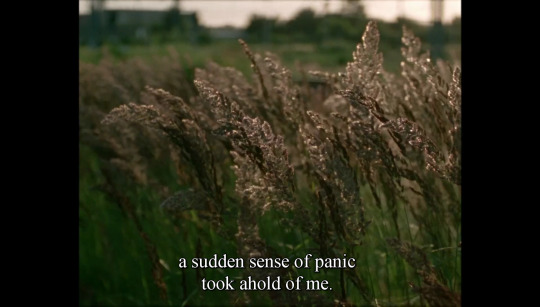

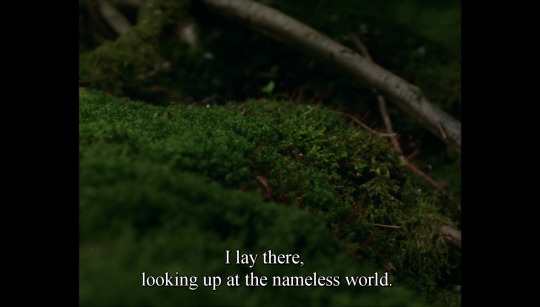

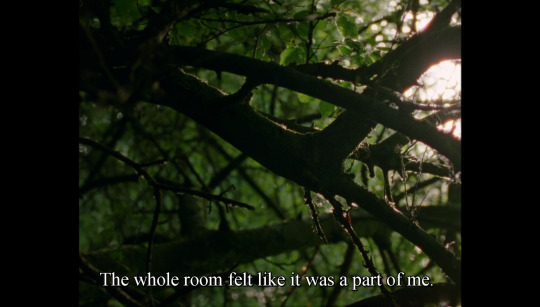
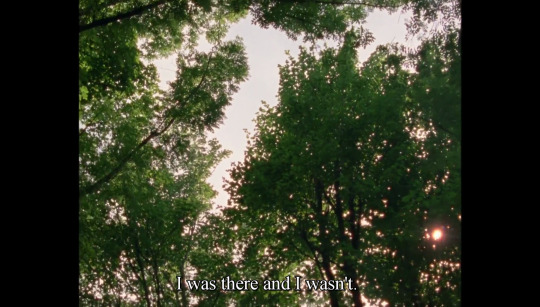

Here (Bas Devos, 2023)
524 notes
·
View notes
Text
Tbh this has been on my mind for MONTHS
Human codes… but they’re not actually codes??
A small group of humans is discovered by some curious aliens. Both sides can assume that the other is sentient. The aliens are trying to translate the humans’ language to their own, and the humans are trying to learn the aliens’ language. But since humans are tricky, they’ve decided that they don’t want the aliens to know their language, so they can have secret conversations.
So they go a little crazy. With written words, they randomly use lowercase and capital letters, even using numbers and symbols, and use a lot of slang, occasionally using words incorrectly on purpose. They’ll jumble the words a bit so that only human brains can guess their meaning (that thing where if you use all the letters and put the proper letters at the beginning and end it’ll be comprehensible), and even use additional or unofficial languages (commonly known words like ‘hola’, ‘si’, ‘oui’, etc, and piglatin, in which you typically take the first letter or syllable of a word, place it at the end, and add ‘ay’ to the end).
As for spoken words, they will do a bit of the above, mashing languages and slang, perhaps mispronouncing a few things, and quoting memes, vines, movies, and even singing parts of songs to throw off the aliens. Perhaps they will say something with a somber meaning in a joyful way to throw off the meaning, or even just naturally (‘I wanna die!’ ‘Mood’), or vice versa.
Additionally, there would have to be a TON of body language. Maybe even sign language, should they know any. Gestures and expressions, eyebrow wiggles and poorly-hidden grins. Ah, the beauties of communication.
#I’m sure there’s more#please add more#aliens#humans#humans are space orcs#haso#humans are space fae#humans are space raccoons#humans are space orcs prompts#humans are weird#humans are insane#humans are terrifying#language#communication#lingustics#? I hope this counts as linguistics??#I’ve had this in my head for an unwritten fic I’ve abandoned before its birth#just humans being clever little pricks#aliens: hello humans! we wish to communicate! please speak as you naturally would!#human: ouldshay eway unray?#other human: *offended look* Bethany. I made BISCUITS *subtle gesturing to alien food*#another human: if I stay there will be trouble~ and if I go there will be double~ so I gotta gotta know~ should I stay or should I go#alien: are we sure these are all the same species? because I’m fairly sure they’re all speaking different languages
2K notes
·
View notes
Note
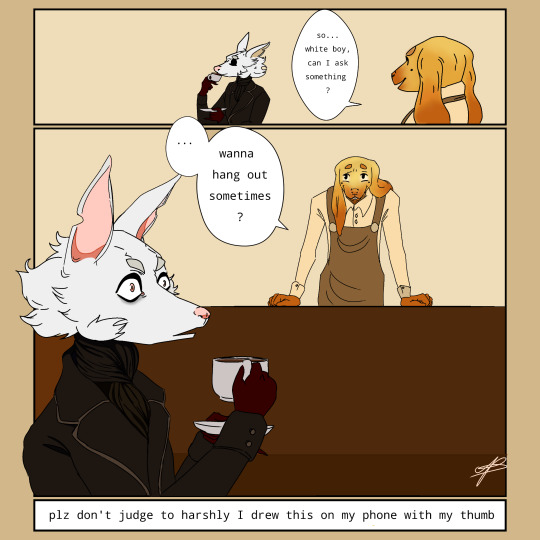
.
#aaaa dangit ;v;#first of all it's honestly unfathomable you managed to draw this on your phone how on earth#you must have some intense fine motor skills to achieve this kind of precision on such a small screen#zero judging necessary#their body language seems so natural yet expressive I love it#the way Vasco is leaning over the counter like he owns the place (he doesn't but certainly does his best to give that impression)#his expression is terribly endearing as well#to me he seems a tiny bit hesitant which is a fun contrast to his confident pose#and Machete sipping his coffee with such finesse#you made him look so refined#but he's just called white boy now#really makes you think of the awkward and drawn-out trying-to-break-the-ice phase that probably preceded this#this is so sweet and you depicted them so well! thank you!#gift art#nejd08#own characters#Vasco#Machete#modern au#I wonder if Vasco is a genuine caffeine wizard#or is he just average at best or even lowkey awful and Machete keeps going there anyway because the barista is cute and nice to him
564 notes
·
View notes
Text



Floriography in my spring garden 🌷 My book is published by Andrews McMeel, and you can find it wherever you like to get your books!
#illustration#artists on tumblr#floriography#flowers#spring flowers#Victorian language of flowers#jessica roux#jessicaroux#nature#floral
1K notes
·
View notes
Note
Hello Mark! I found out about the limnonectes genus recently - why are some of them knobheads? What is the purpose of knob?

The structure is called a caruncle, which sounds like a made-up word, but then again, all words are made up. It is made of connective tissue underneath skin full of mucous glands (studied histologically by Lambertz et al. 2014), but its function is unknown. However, because it is only present in males, I have a well-founded suspicion that it is involved in sexual selection one way or another. I would guess that it is either (a) very intimidating for other males, (b) actually helpful in physical contests among males, (c) very attractive to females, or (d) some combination of the above.
#haunted frogs#frogs#fanged frog#Limnonectes#wildlife#animals#nature#the more you know#as a speaker of British English calling these frogs knobheads is hilarious to me#answers by Mark#frogkiing#caruncle#what a word#immediately makes you want to say carbuncle#language is fun
378 notes
·
View notes
Text



I think he's slowly becoming unrecognizable and turning into a different character, but i can't stop drawing @naffeclipse 's orca siren eclipse on just about every other page of my sketchbook
#art#fanart#apex polarity fanart#siren eclipse#sketches#colored sketches#eclipse fnaf#eclipsed heart#hes so fun to practice shape language with#and also get more into creature design#hes so fun to just. make a quick sketch of#and having the long tail forces me to think of more dynamic poses to make things look natural
208 notes
·
View notes